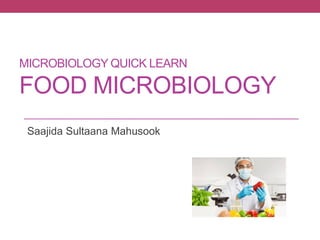Food microbiology- yeast morphology and classification
- 1. MICROBIOLOGY QUICK LEARN FOOD MICROBIOLOGY Saajida Sultaana Mahusook
- 2. YEAST Morphology • Yeasts are unicellular fungi. They are oval or spherical shaped and slightly larger than bacteria. They reproduce by budding or fission. • Yeast may be useful or harmful in food. • Yeast fermentations are involved in the manufacture of foods such as bread, beer, wines, vinegar, and surface- ripened cheese and also in the manufacture of enzymes and food. Yeats are undesirable when they cause spoilage of fruit juices, sauerkraut, syrups, molasses, honey, jellies, meat, wine, beer and other foods.
- 3. Classification of Yeasts • Certain yeasts are represented in two different genera based on whether they produce sexually. True yeast is placed under the subdivision Ascomycotina results in the formation of ascospores. False or asporogenous yeast comes under the subdivision Fungi Imperfectii or Deuteromycotina. • Principal bases for the identification and classification of genera of yeasts are: 1. Whether ascospores are formed 2. If they are spore- forming: i. Method of production of ascospores Produced without conjugation of yeast cells. Spore formation may be followed by a) conjugation of ascospores or b) conjugation of small daughter cells. Produced after isogamic conjugation (conjugating cells appear similar). Produced by heterogamic conjugation (conjugating cells appear different). i. Appearance of ascospores: shape, size and color. Most spores are spheroidal or ovoid. ii. Usual number of ascospores per ascus: one, two, four or eight.
- 4. 3. Appearance of vegetative cells: shape, size and color and inclusions. 4. Method of asexual reproduction: Budding Fission Combined budding and fission Arthrospores (oidia) 5. Production of a mycelium, pseudomycelium or no mycelium. 6. Growth as a film on liquid surface (film yeast) or growth throughout the medium. 7. Color of the macroscopic growth. 8. Physiological Characteristics (to differentiate species or strains within a species) Nitrogen and carbon sources Vitamin requirements Oxidative (film yeasts) or fermentative or both. Lipolysis, urease activity, acid production or formation of starch like compounds.
- 5. Reference • Food Microbiology by Martin R. Adams and Maurice O. Moss, 3rd e. • Food Microbiology by William C. Frazier and Dannis C. Westhoff, 5th e.




